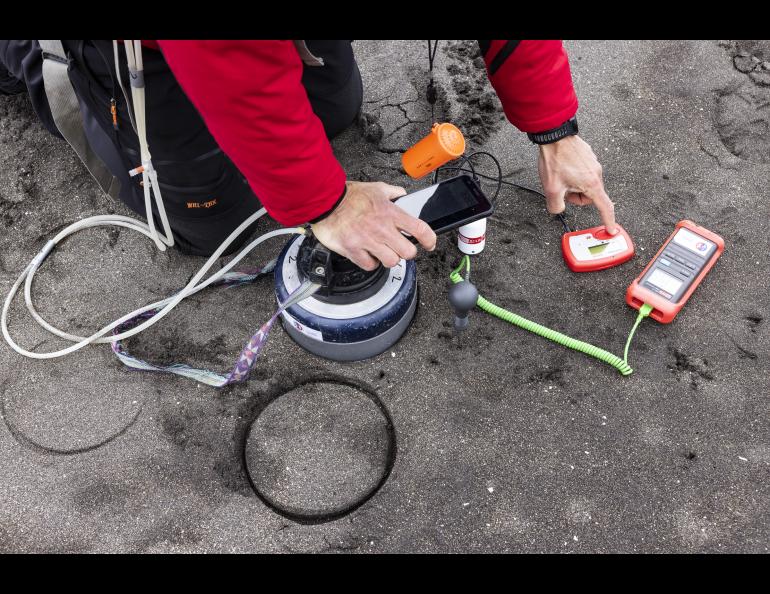
Research work last summer on the Mt. Edgecumbe crater near Sitka has shed some light on what may be happening below the mountain, which began to show signs of life almost two years ago. The movement of magma remains very deep, and isn’t producing any measurable volcanic gases at the surface.
A doctoral researcher at UAF recently shared her data with the Sitka Rotary Club.
The Rotary Club is probably not the first place you’d go for the latest information on volcanology, but when a crater long-thought to be dormant starts rumbling to life about 10 miles from town, no one in Sitka is uninterested.
Claire Puleio is working on her PhD at the University of Alaska Fairbanks. Mt. Edgecumbe caught her eye at about the same time as everyone else, when an earthquake swarm was detected under the crater in the spring of 2022. Subsequent satellite measurements showed that the slopes of the mountain had been deforming at a rate of nearly four inches a year, and surface temperatures on some parts of Kruzof Island were warming.
Puleio spoke to the Sitka Rotary meeting over Zoom.
“And then the other thing that really piqued my interest was a lot of information from people in Sitka about interesting things that they saw on Kruzof,” she said.
A video shot by retired Search and Rescue captain Don Kluting of a small pond percolating with bubbles on Kruzof Island made the rounds in Sitka, as did another gassy phenomenon, this time discovered by a state trooper.
“And then Kyle Ferguson was hiking down along Shoals Point in the southeast portion of the island,” Puleio said, “and he found this hole that had some warm kind of sulfur-smelling air coming out of it, too. So I wanted to explore that as well to see: What is that? And is that even related to the volcano?”
Puleio didn’t elaborate on whether having volcanic gas venting at the surface of Kruzof Island was a good or bad thing – it’s all part of the information she and her partners at the university and the Alaska Volcano Observatory are gathering – in her words – to “understand where we’re headed, and what kind of activity might be there.”
Puleio joined a team who visited Mt. Edgecumbe twice last summer, sampling the air around and above the crater in a helicopter, and collecting samples from the ground using an apparatus about the size of a cookpot turned upside down in the soil – all in search of the signal gas isotopes produced by volcanoes, which differ from those produced through biological processes. About 550 vials of air total, which were shipped off to a lab for chemical analysis.
Then, using information supplied by the trooper, she went looking for the hole and – incredibly – found it.
“So we found this hole,” said Puleio, “and what we did was place that same multigas (detector), which is what we use for the gas flight to measure the gas in the air, we placed that over the opening, you can see that in the lower left hand corner, and then measure the air that’s coming out of this hole.”
It proved not to contain measurable volcanic gases, and Puleio suspects it is actually a lava tube, which is still something.
The bubbling pond was only a little less disappointing. Puleio and a teammate use trail cams to learn what times the pond was percolating, then they clambered into chest waders to collect gas – which turned out to be mostly the result of biological activity, like decaying plants.
“We had no volcanic gas detected at Shoals Point (the location of the hole),” Puleio said, “and then the gas that was measured from that bubbling pond shows no clear volcanic signal, but could potentially have a small contribution from a volcanic source.”
For a volcanologist, it might be a downer that exhaustive sampling of the air around Mt. Edgecumbe turned up very little evidence of volcanic gases. But that doesn’t mean nothing is happening deep under the surface – there’s been plenty of evidence to suggest that the mountain is becoming active, and when there’s any change in the atmosphere of Kruzof Island, Puleio will have a baseline.
“The really great thing is that this establishes a really good background that we can measure against in the future. So if we go back to Edgecumbe, or the AVO goes back, or I have the opportunity to go back, we can collect the same samples again and compare them. And so we can see if anything is changing.”
In the meantime, the Alaska Volcano Observatory has placed four seismic stations on the slopes of Mt. Edgecumbe, and scientists continue to note “sporadic, occasional, small earthquakes” deep below the crater.






























